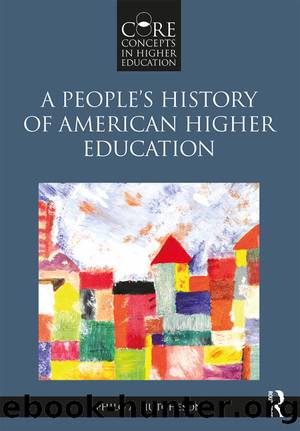A People's History of American Higher Education by Hutcheson Philo A.;

Author:Hutcheson, Philo A.;
Language: eng
Format: epub
Publisher: Taylor & Francis Group
Published: 2019-01-15T00:00:00+00:00
VIETNAM
It seemed to be a time of protest, beginning with protests against segregation and increasingly confrontational protests against the Vietnam War (discussed in Chapter 6 on students). It was also a time of significant shifts in enrollments, brought about in part by the nationâs experience in Vietnam and in part by an increasing commitment to providing broader access to colleges and universities; discussed both in this section and the latter issue of increased access again in Chapter 8 on exclusion and stratification. In addition, the nationâs involvement in Vietnam reinforced the relationships between academic science and the federal government. Finally, and curiously, the Vietnam War brought about skepticism toward colleges and universities, a skepticism that undergirded eventual efforts to ensure that public institutions of higher education had less public financial support and colleges and universities focused on efficiency.
Shortly after the veterans returned from service in World War II, the nation experienced what is called the Baby Boom, an extraordinary rate of growth in the number of babies born each year. Initially, of course, the population growth put a strain on the nationâs schools, starting in the mid-1950s and continuing to the late 1960s and early 1970s. By the late 1950s, colleges and universities began to experience the pressure on enrollments, and the growth of college enrollments became extraordinary, as did the growth of institutions of higher education. For example, for a while at the end of the 1960s, states were establishing community colleges at the average of one per week. Enrollment growths at four-year colleges, especially at public institutions, were equally remarkable. According to the Digest of Educational Statistics, there were about 2.3 million students enrolled at colleges and universities in 1947, 4.1 million in 1961, and 8.5 million in 1970; hence in two decades, college and university enrollment essentially doubled each decade. Part of the reason for the enrollment growth was the male student response, particularly among white men, to the nationâs Selective Service exclusion from the draft of men enrolled in college. There was also a declared war that had a direct impact on enrollment, the War on Poverty, which President Lyndon Baines Johnson declared in 1964. He saw education as one of the key means for eradicating poverty, and proposed legislation that went far beyond the G.I. Bill and the National Defense Education Act because the only criterion for eligibility was family or student income. Federal funding for scholarships and loans accelerated in 1965 with the passage of the Higher Education Act authorizing 1.2 billion dollars in support for higher education, including loans and grants; lower-income students found new ways to afford college.50 This law represents the first full-scale use of federal dollars to provide financial assistance to students in higher education, without targeting them on the basis of national defense interests or service to the nation, and the enormity of the financial commitment (more than the amount authorized to support public schools in the Elementary and Secondary Education Act of 1965 despite the far larger number
Download
This site does not store any files on its server. We only index and link to content provided by other sites. Please contact the content providers to delete copyright contents if any and email us, we'll remove relevant links or contents immediately.
Macmillan Primary Grammar 2 Pupil's Book by Unknown(377)
Figuring Out Fluency in Mathematics Teaching and Learning, Grades K-8 by Jennifer M. Bay-Williams & John J. SanGiovanni(342)
The Principal's Guide to Curriculum Leadership by Sorenson Richard D.;Goldsmith Lloyd M.;Mendez Zulma Y.;Maxwell Karen T.;(265)
English Grammar Practice--The Noun by Roxana Nastase(228)
Learning from Accidents 3rd ed by Trevor Kletz (2001)(226)
Harnessing Technology for Deeper Learning by Scott McLeod(214)
Text-Dependent Questions, Grades K-5 by Douglas Fisher & Nancy Frey & Heather Anderson & Marisol Thayre(208)
A Guide to Curriculum Mapping by Hale Janet A.;(201)
English Language Program Administration by Unknown(199)
Deep Change Leadership by Reeves Douglas;(189)
How to Do Everything with Google Tools by Unknown(188)
The Grammar Teacher's Activity-a-Day by Jack Umstatter(177)
The Power of SMART Goals by Conzemius Anne;O'Neill Jan; & Anne Conzemius(175)
Beyond the RTI Pyramid by Bender William N.;(157)
Aligning and Balancing the Standards-Based Curriculum by Squires David A.;(156)
Using Data to Close the Achievement Gap by Johnson Ruth S.;(156)
Using Equity Audits to Create Equitable and Excellent Schools by Skrla Linda E.;McKenzie Kathryn B.;Scheurich James Joseph;(151)
Differentiated Instructional Strategies for the Block Schedule by Gregory Gayle H.;Herndon Lynne E.; & Lynne E. Herndon(142)
You've Got to Reach Them to Teach Them by Schreck Mary Kim; & Schreck(140)
